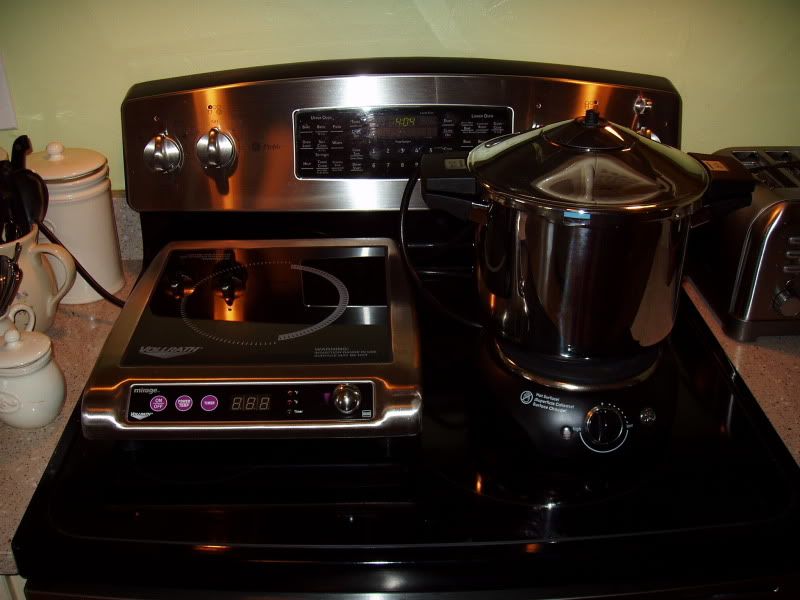Most of us store dried things like beans and rice for long term storage. Cooking usually involves boiling and simmering which can consume large amounts of energy. So I did a little experiment with cooking some dried black beans.
In a grid down scenario electricity would be a scarce commodity. Some of us like myself have off grid renewable production capability but would need to manage it wisely to get the most accomplished for the least amount used. I wanted to see how much electricity would be used cooking black beans in various ways.
I took one cup of dried black beans and soaked them for 6 hrs in each experiment before cooking. They were then cooked in 4 cups of room temp water to start according to directions for each method.
These are the tools used to cook them:

A Kuhn Rikon Duromatic 6 litre pressure cooker
A Vollrath 59500P Mirage Pro Countertop Induction Range 1800 watt
A General Electric hot plate 1000 watt
Kill-a-watt meter to measure total kwhs.
Here are the results:
1) Beans soaked 6 hrs then cooked in 4 cups water in the pressure cooker for 12 min using the induction cook top. Energy used .25 kwh
2) Beans soaked 6 hrs then cooked in 4 cups water in the pressure cooker for 12 min using the hot plate. Energy used .30 kwh
3) Beans soaked 6 hrs then cooked in 4 cups water in the pressure cooker NOT under pressure. Brought to a boil then simmered for 2 hrs. using the hot plate. Energy used .97 kwh
4) Beans soaked 6 hrs then cooked in 4 cups water in the pressure cooker NOT under pressure.
Brought to a boil then simmered for 2 hrs. using the induction cook top. Energy used .80 kwh
Results were pretty interesting. Using induction capable cookware and an induction cook top where the cooking method was the same in each instance consumed about 20% less electricity.
There was no contest between pressure cooking and the standard boil/simmer. Boil/simmer with a hotplate used about 400% more energy than pressure/induction did.
On a side note I just got the induction cook top a couple months ago. These things are amazing. You can go from a cold pan with some butter in it to done scrambled eggs in around 2 minutes.
In a grid down scenario electricity would be a scarce commodity. Some of us like myself have off grid renewable production capability but would need to manage it wisely to get the most accomplished for the least amount used. I wanted to see how much electricity would be used cooking black beans in various ways.
I took one cup of dried black beans and soaked them for 6 hrs in each experiment before cooking. They were then cooked in 4 cups of room temp water to start according to directions for each method.
These are the tools used to cook them:

A Kuhn Rikon Duromatic 6 litre pressure cooker
A Vollrath 59500P Mirage Pro Countertop Induction Range 1800 watt
A General Electric hot plate 1000 watt
Kill-a-watt meter to measure total kwhs.
Here are the results:
1) Beans soaked 6 hrs then cooked in 4 cups water in the pressure cooker for 12 min using the induction cook top. Energy used .25 kwh
2) Beans soaked 6 hrs then cooked in 4 cups water in the pressure cooker for 12 min using the hot plate. Energy used .30 kwh
3) Beans soaked 6 hrs then cooked in 4 cups water in the pressure cooker NOT under pressure. Brought to a boil then simmered for 2 hrs. using the hot plate. Energy used .97 kwh
4) Beans soaked 6 hrs then cooked in 4 cups water in the pressure cooker NOT under pressure.
Brought to a boil then simmered for 2 hrs. using the induction cook top. Energy used .80 kwh
Results were pretty interesting. Using induction capable cookware and an induction cook top where the cooking method was the same in each instance consumed about 20% less electricity.
There was no contest between pressure cooking and the standard boil/simmer. Boil/simmer with a hotplate used about 400% more energy than pressure/induction did.
On a side note I just got the induction cook top a couple months ago. These things are amazing. You can go from a cold pan with some butter in it to done scrambled eggs in around 2 minutes.
Comment